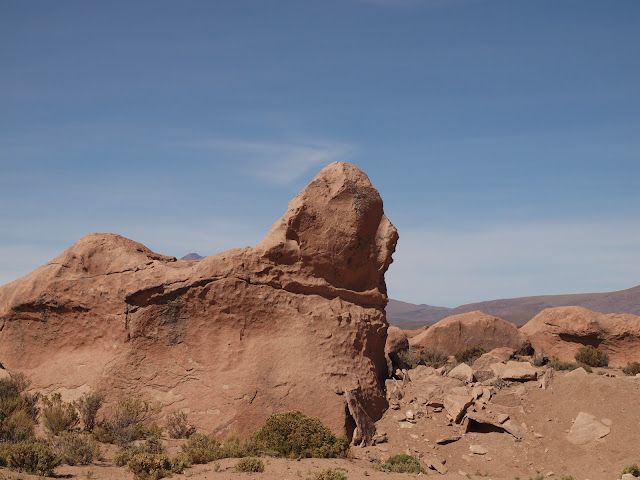After a good catch up, rest wise, and chat about NZ with
Ross it was time to get going.
From Arica
to Copiapo, some 1300 km and 2 1/2 days, is a relatively boring ride. The
highway follows the same desert plateau broken with the occasional ravine
eroded through the underlying gravel layers. After Iquique the scenery changes to sea on the
right and barren hills on the left. OK so it is a surfers paradise on the
right. Only short surf breaks thou due to depth. They anchor full size cargo
vessels here within 400 meters of shore. You do have to put up with an over-powering
stench of Guano.
Traffic is light consisting mainly of trucks and with little
variation in scenery the option is to follow the locals example, open the
throttle while watching the fuel gauge drop and checking the GPS for the distance to the next
fuel dump.
The drawback to constant scenery and speed is an increase in
risk taking by drivers. In the space of one morning there has been 2 crashed
and burnt out vehicles. A tour bus driver who has pulled out into oncoming
traffic to pass two trucks and ended up planted in the front of a car. Bus
windscreen and driver missing! A light truck, either forced off-road or driver
sleeping has rolled out into the desert. Road-toll 20,000 potatoes mashed or
left to bake in the sunshine beside the truck remnants. And later, a car which
has appeared to get out of control on a straight stretch of road and rolled. The
accident site was well attended with Police and other ambulance staff so I can
only hope for the best for the accident victims. Hats off to the Police and Ambulance
staff worldwide who have to attend these accidents.
From Antofagasta
I tried to follow route 1 on down the coast. But the road soon turned to a rock
coastal track which meant backtracking to join route 5 and more desert with a
Mars landscape. Just check out the Mars Rover photos. (Must be the place the
wee green men from mars came to take photos which they later held up in front
of the Mars Rover cameras. OK so the desert is getting to me!)
From Copiapo my intended route over Paso de Penal Negra to Argentina , had
to be shelved. I could not get any reliable information re whether there was a border
control there. Rather than get there just to turn around and come back I headed
south for another high-speed run to La Serena.
Then it was back into interesting terrain following a river
valley to the East and over Portezuelo del Aqua Negra into Argentina ..
From La Serena heading East you enter a fertile valley almost
overrun with vineyards. As you climb higher the vineyards finally end and it is
rock walls. The border post is about 78 km short of the actual border and pass,
and a further 160 km from the pass to the Argentine Border post located at Los
Flores.
The route climbs to about 15500 feet with amazing scenery.
High altitude glacier fields and with the road cut through permanent ice.
Colours and terrain are spectacular.
I stopped the night in Rodeo, at a great sheltered camp
ground, joining 3 German adventure
riders on their way to Uruguay and 2 Swiss riders taking there time heading
North one town at a time. They do not cover
more than 150 -200 km at a time.
Summer has arrived in Argentina with the temperatures
soaring. On Ruta 40 south to San Juan
I got absolutely baked. I stopped early at a hostel in the middle of San Juan to get some
respite from the heat. No good … the whole city was baking and I was still
sitting on the roof terrace with most of the guests at 0230 in the morning
trying to get cool.
Next day it was on down Ruta 40 to Mendoza ,
a hook right through a national park and over the pass back into Chile . The
Border post is a joint run affair with Argentina
and Chile .
They are obviously expecting the summer rush to start with a large number of
kiosks set up to process immigration, police, Ag and customs requirements. OK
if you are in a car, but when you first arrive you are handed most of the forms
in one lump.
Its freezing ,…the wind is blowing 25 KPH…, you have to remain outside the kiosks and somehow fill in all these forms without having to chase them back to Argentina . You
then work your way, on bike, past these kiosks with blacked out windows
and hand over the ever so slightly mangled forms.
If you have ever seen those wind-up boxes where you place a
coin on top, then a hand comes out of the box and grabs it…that’s how these
kiosks work. The catch is you have to be ready when the hand tosses the
paperwork back!
As it was it took an age and eventually I got sent back to Argentina to get
a Chilean temporary import number for the bike…..don’t ask!!!
The fun side was getting away from the border onto some marvelous
switch backs. An added bonus for me as the last fuel station the GPS faithfully
told me was there had vanished so I was very low on fuel. Coasting downhill
through the switchbacks for 25 km certainly helped make it to the next station.
Great tunnels as well.
Then it was onto Santiago ,
Rush Hour and a GPS the does not recognize the one-way system and tried to put
me through a shopping mall. Talk about adventure riding!!
Even got to ride past the intended hotel 3 times before
taking a short-cut and accidentally ending up in the underground park of the
very hotel I was trying to get to.
Magic when things come together!
















































